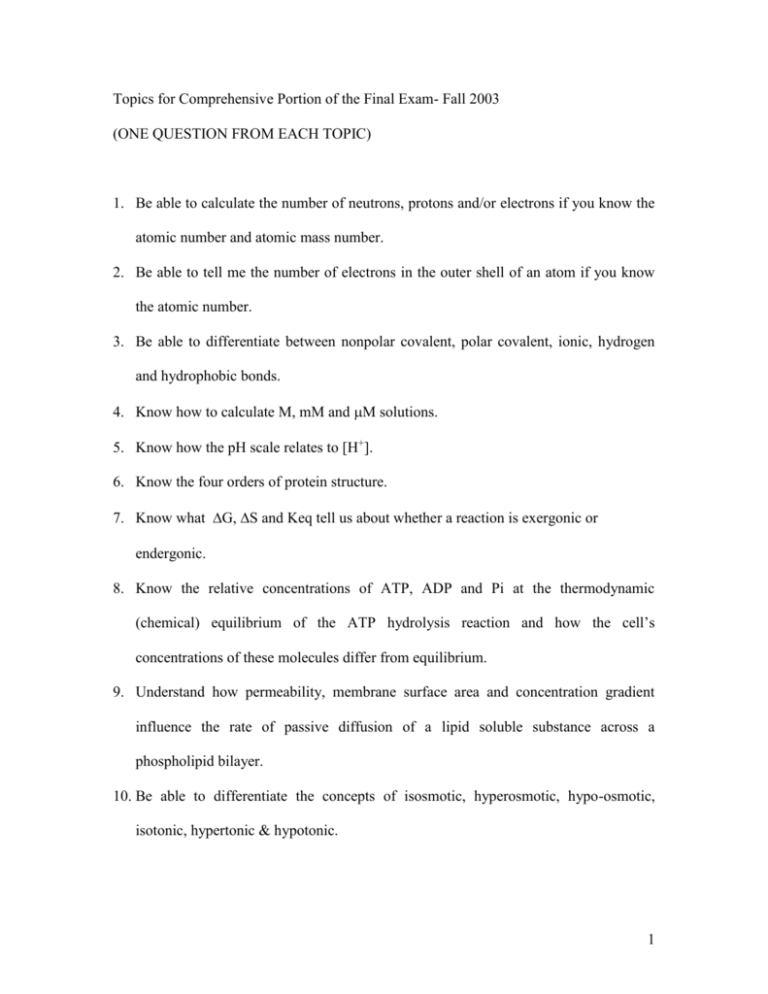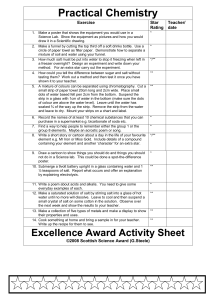doc
advertisement

Topics for Comprehensive Portion of the Final Exam- Fall 2003 (ONE QUESTION FROM EACH TOPIC) 1. Be able to calculate the number of neutrons, protons and/or electrons if you know the atomic number and atomic mass number. 2. Be able to tell me the number of electrons in the outer shell of an atom if you know the atomic number. 3. Be able to differentiate between nonpolar covalent, polar covalent, ionic, hydrogen and hydrophobic bonds. 4. Know how to calculate M, mM and M solutions. 5. Know how the pH scale relates to [H+]. 6. Know the four orders of protein structure. 7. Know what G, S and Keq tell us about whether a reaction is exergonic or endergonic. 8. Know the relative concentrations of ATP, ADP and Pi at the thermodynamic (chemical) equilibrium of the ATP hydrolysis reaction and how the cell’s concentrations of these molecules differ from equilibrium. 9. Understand how permeability, membrane surface area and concentration gradient influence the rate of passive diffusion of a lipid soluble substance across a phospholipid bilayer. 10. Be able to differentiate the concepts of isosmotic, hyperosmotic, hypo-osmotic, isotonic, hypertonic & hypotonic. 1 11. Be able to recognize a redox reaction and know which substance is oxidized, which is reduced, which is the oxidant and which is the reductant. 12. Understand the free energy changes that take place in redox reactions and the relative differences in G, H+ pumped and ATP synthesized for the complete oxidation of NADH vs. FADH2. 13. Understand the differences between cyclic and non-cyclic photophosphorylation. 14. Know the role of Rubisco. 15. Know the base pairing rules and how these rules apply to both DNA and RNA and the basic structure of a DNA molecule. 16. Understand the nature of the genetic code including issues such as word size, redundancy, reading frame etc. and be able to translate a nucleotide sequence into a peptide sequence using a codon dictionary. 17. Understand the basic process underlying the tryp and lac operons.. 18. Know the two factors that determine the amount of blood flow through a blood vessel.. 19. Understand the basic differences between air and water as respiratory media. 20. Understand the concept of oxygen partial pressure and the reversible binding of oxygen to respiratory pigments. Practice questions for last four lectures of course. 1. Animals living in the open oceans _____________, (A) will most likely be euryhaline, (B) will most likely be stenohaline, (C) will have body fluids that are 2 MUCH MORE concentrated than sea water, (D) face frequent changes in the salt concentration of their environment, or (E) none of the above. 2. A marine boney (teleost) fish________. (A) is an osmoregulator, (B) is losing water to the medium it lives in, (C) has a blood salt concentration less than that of the medium, (D) constantly gains salt passively from the medium or (E) all of the above. 3. Animals found in the Great Salt Lake or Dead Sea _____. (A) are osmoregulators, (B) lose water to the medium they live in, (C) have blood salt concentrations less than that of the medium, (D) constantly gain salt passively from the medium or (E) all of the above. 4. Marine birds _____. (A) avoid drinking seawater, (B) actively take up extra salts to compensate for salts lost to the medium, (C) excrete excess salt by a salt gland, (D) have blood that is more concentrated than the medium or (E) none of the above. 5. Mammals conserve water by _____: (A) producing a dilute, copious urine, (B) by secreting a very salty fluid from a salt gland, (C) producing a dry feces, (D) all of the above or (E) none of the above. 6. Which of the following is NOT a normal constituent of mammalian urine (A) protein, (B) water, (C) NaCl, (D) all of the above or (E) none of the above. 7. As the urine passes through the nephron unit all of the following EXCEPT ________ is (are) typically reabsorbed. (A) water, (B) Na+, (C) glucose, (D) Cl- or (E) toxins. 8. Under normal circumstances, your urine should ______. (A) be relatively large in volume, (B) contain red blood cells, (C) be very hypo-osmotic with respect to the blood plasma, (D) be hyper-osmotic with respect to the blood plasma, or (E) none of the above. 9. The nitrogen excretory product which results in the largest amount of water loss is _____. (A) ammonia, (B) lactate, (C) uric acid, (D) urea or (E) none of the above. 10. A _________________ is a substance which is released by a cell other than a neuron which has a local effect. (A) second messenger, (B) neurohormone, (C) hormone, (D) paracrine secretion or (E) none of the above. 11. Which of the following is (are) true about protein/peptide hormones? (A) bind to plasma membrane receptors, (b) cannot penetrate plasma membranes, (C) typically produce second messengers, (D) all of the above or (E) none of the above. 3 12. The concentration of potassium in a neuron _____________. (A) is lower than in the extracellular space, (B) is higher than in the extracellular space, (C) is regulated by the Na+:K+ ATPase, (D) A & B or (E) B & C. 13. __________ are neurons involved in controlling the internal organs. (A) Interneurons, (B) Sensory neurons, (C) Autonomic neurons, (D) Motor neurons or (E) none of the above. 14. During the rising phase of the action potential_________________. (A) the membrane is very permeable to sodium, (B) sodium is flowing into the neuron, (C) the membrane potential is getting less negative, (D) all of above or (E) none of the above. KEY to practice questions for last four lectures of course. 1. Animals living in the open oceans _____________, (A) will most likely be euryhaline, (B) will most likely be stenohaline, (C) will have body fluids that are MUCH MORE concentrated than sea water, (D) face frequent changes in the salt concentration of their environment, or (E) none of the above. 2. A marine boney (teleost) fish________. (A) is an osmoregulator, (B) is losing water to the medium it lives in, (C) has a blood salt concentration less than that of the medium, (D) constantly gains salt passively from the medium or (E) all of the above. 3. Animals found in the Great Salt Lake or Dead Sea _____. (A) are osmoregulators, (B) lose water to the medium they live in, (C) have blood salt concentrations less than that of the medium, (D) constantly gain salt passively from the medium or (E) all of the above. 4. Marine birds _____. (A) avoid drinking seawater, (B) actively take up extra salts to compensate for salts lost to the medium, (C) excrete excess salt by a salt gland, (D) have blood that is more concentrated than the medium or (E) none of the above. 5. Mammals conserve water by _____: (A) producing a dilute, copious urine, (B) by secreting a very salty fluid from a salt gland, (C) producing a dry feces, (D) all of the above or (E) none of the above. 6. Which of the following is NOT a normal constituent of mammalian urine (A) protein, (B) water, (C) NaCl, (D) all of the above or (E) none of the above. 4 7. As the urine passes through the nephron unit all of the following EXCEPT ________ is (are) typically reabsorbed. (A) water, (B) Na+, (C) glucose, (D) Cl- or (E) toxins. 8. Under normal circumstances, your urine should ______. (A) be relatively large in volume, (B) contain red blood cells, (C) be very hypo-osmotic with respect to the blood plasma, (D) be hyper-osmotic with respect to the blood plasma, or (E) none of the above. 9. The nitrogen excretory product which results in the largest amount of water loss is _____. (A) ammonia, (B) lactate, (C) uric acid, (D) urea or (E) none of the above. 10. A _________________ is a substance which is released by a cell other than a neuron which has a local effect. (A) second messenger, (B) neurohormone, (C) hormone, (D) paracrine secretion or (E) none of the above. 11. Which of the following is (are) true about protein/peptide hormones? (A) bind to plasma membrane receptors, (b) cannot penetrate plasma membranes, (C) typically produce second messengers, (D) all of the above or (E) none of the above. 12. The concentration of potassium inside a neuron _____________. (A) is lower than in the extracellular space, (B) is higher than in the extracellular space, (C) is regulated by the Na+:K+ ATPase, (D) A & B or (E) B & C. 13. __________ are neurons involved in controlling the internal organs. (A) Interneurons, (B) Sensory neurons, (C) Autonomic neurons, (D) Motor neurons or (E) none of the above. 14. During the rising phase of the action potential_________________. (A) the membrane is very permeable to sodium, (B) sodium is flowing into the neuron, (C) the membrane potential is getting less negative, (D) all of above or (E) none of the above. 5








